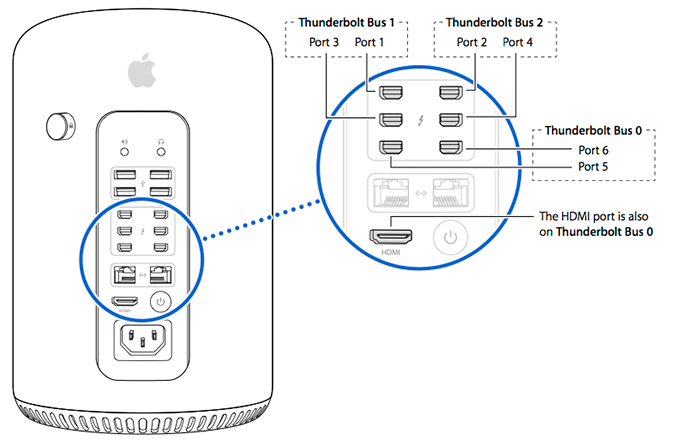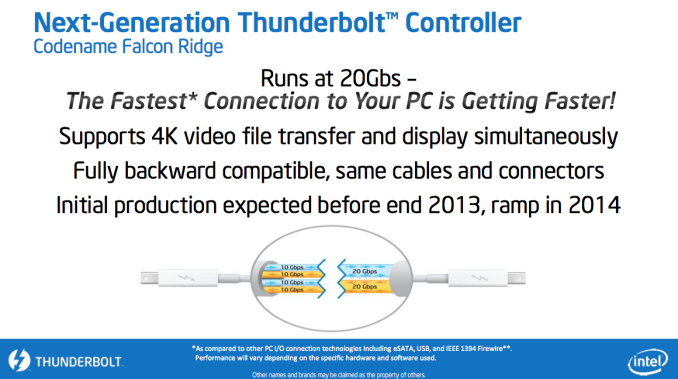The Mac Pro Review (Late 2013)
by Anand Lal Shimpi on December 31, 2013 3:18 PM ESTThunderbolt 2
The new Mac Pro integrates three Intel Falcon Ridge Thunderbolt 2 controllers. These are the fully configured controllers, each supporting and driving two Thunderbolt 2 connectors on the back of the Pro for a total of 6 ports.
Pairing Thunderbolt 2 with Ivy Bridge EP is a bit tricky as Apple uses Thunderbolt 2 for display output as well as data. Typically you’d route all display through processor graphics, but in the case of IVB-EP there is no integrated graphics core. On a DIY PC you enable display output over Thunderbolt 2 by running an extra cable out of the discrete GPU and into a separate input that muxes the signal with PCIe and ships it out via another port as Thunderbolt. Here’s where Apple’s custom PCB work comes in handy as all of this is done internal to the Mac Pro. The FirePro’s display outputs are available via any two of the six Thunderbolt 2 ports, as well as the lone HDMI port on the back of the Mac Pro.
How does Thunderbolt 2 differ from the original? For starters, it really would’ve been more accurate to call it Thunderbolt 4K. The interface is fully backwards compatible with Thunderbolt 1.0. You can use all previous Thunderbolt peripherals with the Mac Pro. What’s new in TB2 is its support for channel bonding. The original Thunderbolt spec called for 4 independent 10Gbps channels (2 send/2 receive). That meant no individual device could get access to more than 10Gbps of bandwidth, which isn’t enough to send 4K video.
Thunderbolt 2 bonds these channels together to enable 20Gbps in each direction. The total bi-directional bandwidth remains at 40Gbps, but a single device can now use the full 20Gbps. Storage performance should go up if you have enough drives/SSDs to saturate the interface, but more importantly you can now send 4K video over Thunderbolt. Given how big of a focus 4K support is for Apple this round, Thunderbolt 2 mates up nicely with the new Mac Pro.
So far I’ve been able to sustain 1.38GB/s of transfers (11Gbps) over Thunderbolt 2 on the Mac Pro. Due to overhead and PCIe 2.0 limits (16Gbps) you won’t be able to get much closer to the peak rates of Thunderbolt 2.

The impact of chaining a 4K display on Thunderbolt 2 downstream bandwidth
Here’s where the six Thunderbolt 2 and three TB2 controllers come into play. Although you can daisy chain a 4K display onto the back of a Thunderbolt 2 storage device, doing so will severely impact available write bandwidth to that device. Remember that there’s only 20Gbps available in each direction, and running a 3840 x 2160 24bpp display at 60Hz already uses over 14Gbps of bandwidth just for display. I measured less than 4Gbps of bandwidth (~480MB/s) available for writes to a Thunderbolt 2 device downstream from the Mac Pro if it had a 4K display plugged in to it. Read performance remained untouched since display data only flows from host to display, leaving a full 20Gbps available for reads. If you’re going to connect Thunderbolt 2 devices to the Mac Pro as well as a 4K display, you’ll want to make sure that they aren’t on the same chain.
If we start numbering in the top left corner of the 2 x 3 array of Thunderbolt ports and go left to right down the stack, you'll want to first populate ports 1, 2 and 5 before filling in the rest. The diagram below should help simplify:












267 Comments
View All Comments
Ryan Smith - Wednesday, January 1, 2014 - link
The device ID for the D700 is identical to the 7970 (1002-6798), so it will show up as a Radeon under Windows. Conversely, a 7970 may very well show up as a D700 under Mac OS X if the only thing being checked is the device ID.666sheep - Thursday, January 2, 2014 - link
It used to be device ID only, but it has changed in 10.9.2 drivers. Now 7970 (and 7870 XT) are recognized as "themself", like in 10.8. So there's another check, most likely vendor and/or subsystem ID.BTW, D500 and D700 are based on the same core - Tahiti XT2 and share one EFI ROM (but not the PC part, these are different for each card). I sent Anand an email with more detailed info.
tipoo - Thursday, January 2, 2014 - link
But can you install FirePro drivers for it under Windows?666sheep - Friday, January 3, 2014 - link
I doubt that at this moment drivers other than Apple Bootcamp ones will detect these cards as FirePro. One should test this empirically, though.wheelhot - Saturday, January 4, 2014 - link
Yes, I'm one of them as I'm using Solid Edge in Windows and wonders if the D300/500/700 is supplied with actual FirePro drivers in Windows or not. Anyone care to clarify?I've been searching for anyone to run a specviewperf test as it'll be easier to know if they truly comes with a FirePro GPU drivers or not in Windows, sadly none yet :(
melgross - Tuesday, December 31, 2013 - link
I'd like to see a comparison pricing between the Mac Pro and a DIY machine using the same processors, not the i7. Whatever the difference, it's not the same type of machine if the CPU's are entirely different. That price difference, and possibly that of the mobo will be drastic, I would imagine, and would be a fairer comparison.acrown - Tuesday, December 31, 2013 - link
Lucky for you that someone did that already then:http://www.futurelooks.com/new-apple-mac-pro-can-b...
Spoiler - the Mac Pro is cheaper when you attempt to keep the same design restraints.
lilo777 - Tuesday, December 31, 2013 - link
Don't be ridiculous. The guy has no clue. He used two AMD W9000 cards as if this is is what D700 is.itpromike - Tuesday, December 31, 2013 - link
Apparently you have no clue... The W9000 is spec for spec the exact same card as the D700. Every single spec and number are identical. Aside from Apples stupid and pointless naming convention this card is the same.KVFinn - Tuesday, December 31, 2013 - link
>The W9000 is spec for spec the exact same card as the D700. Every single spec and number are identical.The W9000 is different, it has ECC ram for example. It's spec for spec the same as the 7970 but clocked lower.
Though most of the differences in Pro grade GPU are confined to drivers.